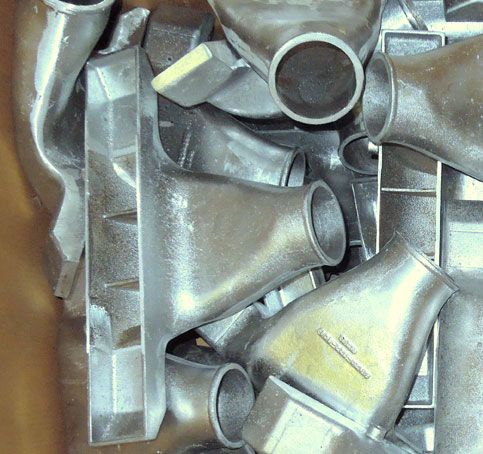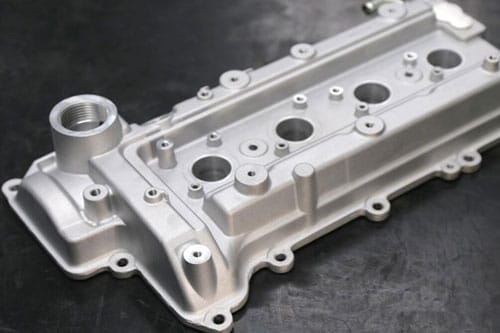Aluminum Foundry and Metal Castings: reliable choices for industrial needs
Exploring the Versatile Utilizes and Applications of Aluminum Castings in Modern Industries
Light weight aluminum spreadings have actually become important to different contemporary markets because of their one-of-a-kind residential properties. They supply considerable advantages in weight decrease, thermal conductivity, and deterioration resistance. From auto advancements to applications in durable goods and construction, their convenience is impressive. Yet, truth degree of their influence expands past immediate advantages, meaning broader effects for sustainability and performance. What lies ahead for light weight aluminum spreadings in an ever-evolving commercial landscape?
Automotive Sector Innovations
The automotive sector has actually significantly welcomed aluminum spreadings to enhance lorry efficiency and efficiency. By utilizing light weight aluminum, manufacturers can generate lighter elements, which add to enhanced gas economic climate and decreased exhausts. Key applications include engine blocks, transmission situations, and architectural components, where the product's strength-to-weight ratio supplies longevity without adding excess weight.
Light weight aluminum castings also offer exceptional thermal conductivity, which aids in much better heat dissipation, consequently improving engine performance. Developments in casting technologies, such as die spreading and sand spreading, allow the production of complicated geometries, allowing for innovative styles that maximize room and performance.
The recyclability of aluminum aligns with sustainability objectives in the auto sector, promoting eco-friendly practices. As the market continues to introduce, making use of aluminum spreadings is likely to increase, driving additional advancements in car layout and performance.
Aerospace Applications and Innovations
While the aerospace sector remains to prioritize weight decrease and fuel performance, aluminum spreadings have become a crucial material option for numerous applications. Their light-weight nature, coupled with high strength-to-weight ratios, enables substantial enhancements in aircraft performance and efficiency. Light weight aluminum spreadings are generally utilized in structural elements, such as body frameworks and wing parts, where minimizing weight is vital.
Recent developments in light weight aluminum spreading innovations, including improved alloy solutions and accuracy casting techniques, have actually even more improved the product's performance capacities. These innovations enable the manufacturing of complex geometries and elaborate designs while maintaining structural honesty. In addition, light weight aluminum's outstanding deterioration resistance assurances long life and dependability in extreme aerospace settings.
As the aerospace field progressively embraces sustainability, light weight aluminum spreadings use a recyclable solution that aligns with green techniques, making them a crucial aspect in the growth of next-generation aircraft.
Durable Goods and Everyday Products
As customers progressively look for light-weight yet sturdy products for everyday products, light weight aluminum spreadings have actually gotten appeal in various consumer products. The unique homes of light weight aluminum, including its resistance to rust and outstanding thermal conductivity, make it a perfect selection for products like kitchenware, home devices, and exterior gear. For instance, light weight aluminum cast pans and pots offer even warm distribution, enhancing cooking effectiveness. In addition, making use of light weight aluminum in things such as bicycle frameworks and baggage ensures a balance between stamina and transportability. Suppliers appreciate light weight aluminum spreadings for their versatility, as they can be conveniently built right into complicated forms while keeping architectural honesty. The capacity to reuse light weight aluminum without deteriorating its properties straightens with growing consumer choices for lasting items. Generally, aluminum spreadings are important to the manufacturing of durable, functional, and cosmetically pleasing durable goods, fulfilling the demands of modern way of livings.
Construction and Architectural Uses
Light weight aluminum castings have become an essential component in construction and architectural design, especially due to their strength and lightweight nature. These residential or commercial properties make light weight aluminum an excellent option for various applications, consisting of structural elements, facades, and ornamental functions - Metal Castings. Designers and home builders progressively utilize light weight aluminum spreadings for window frames, doors, and roof, boosting both performance and visual appeals. The material's resistance to rust further extends its life-span, decreasing upkeep costs and making sure toughness in diverse ecological conditions
Aluminum can be easily formed right into complex styles, permitting for cutting-edge architectural expressions. Its versatility assists in the development of personalized pieces that fulfill details layout demands, from luxuriant railings to intricate supports. As sustainability ends up being a concern, light weight aluminum's recyclability contributes to its appeal in eco-friendly building methods. Generally, light weight aluminum spreadings are revolutionizing the building and construction market by supplying lightweight, sturdy, and aesthetically enticing services.
Electrical and Digital Elements
Light weight aluminum spreadings play a vital duty in the production of light-weight electrical units, which enhance mobility and performance in numerous applications. In addition, their superb thermal conductivity makes them excellent for warm sinks, ensuring peak efficiency and long life of digital elements. Light weight aluminum's conductive buildings contribute to its use in various electrical conductors, highlighting its importance in modern innovation.
Lightweight Electrical Rooms
Light-weight electrical enclosures play a necessary duty in safeguarding sensitive electronic elements from ecological aspects and physical damage. Created from aluminum castings, these rooms are valued for their strength-to-weight ratio, making them perfect for various applications throughout markets. Their light-weight nature aids in lowering total system weight, which is important in mobile and mobile electronics. Light weight aluminum's corrosion resistance boosts toughness, extending the lifespan of the enclosed components. The ability to mold and mildew aluminum into complex forms allows for customized layouts, providing to details requirements while ensuring efficient heat dissipation. Additionally, these units can be easily integrated right into existing systems, supplying adaptability and convenience in contemporary technical settings. In general, light-weight light weight aluminum units considerably add to the effectiveness of electronic tools.
Warmth Sinks and Conductors
While several products are used in electronic elements, light weight aluminum castings stick out for their performance in heat management as warmth sinks and conductors. Their superb thermal conductivity permits for effective warm dissipation, which is vital in preventing the overheating of electronic gadgets. Light weight aluminum's lightweight nature even more enhances its viability for applications where weight is a significant factor, such as in aerospace and vehicle industries. In addition, aluminum castings can be conveniently formed into complex shapes, providing design versatility for maximizing thermal performance. The corrosion resistance of light weight aluminum additionally adds to the durability and dependability of these elements in various settings. As modern technology breakthroughs and gadgets end up being more small, the demand for reliable warm management options, like light weight aluminum spreadings, continues to expand.
Marine Sector Application
The marine sector progressively depends on light weight aluminum spreadings for their remarkable resilience and corrosion resistance. These residential or commercial properties make aluminum an ideal option for numerous applications, including boat hulls, engine elements, and aquatic equipment. The lightweight nature of light weight aluminum castings makes it possible for boosted gas efficiency and easier maneuverability in boat, which is necessary for both business and entertainment vessels.

Light weight aluminum castings additionally give significant expense advantages due to their lengthy life expectancy and reduced upkeep demands, lowering the total functional costs for aquatic operators. In addition, the versatility of light weight aluminum permits intricate designs that can fulfill particular efficiency requirements.
Makers in the marine field utilize innovative casting techniques to produce complex forms, ensuring that parts meet extensive safety and efficiency criteria. As the need for high-performance marine vessels grows, aluminum castings are placed as a crucial product in improving the capability and durability of marine tools.
Sustainability and Recycling in Aluminum Casting

Aluminum Recycling Refine
Reusing helpful hints aluminum plays an important role in minimizing ecological impact and conserving resources within the casting sector. The aluminum recycling procedure begins with the collection of scrap light weight aluminum, which can include old parts, making waste, and post-consumer products. This scrap is then sorted, cleansed, and shredded into tiny pieces to promote melting.
Once prepared, the aluminum scrap is melted in a heating system at lower temperatures than key aluminum manufacturing, significantly reducing power intake. The molten aluminum is after that cast right into ingots or other shapes for reuse in numerous applications - Metal Castings. This closed-loop system permits the reliable recuperation of aluminum, protecting its properties while minimizing the need for virgin materials. The reusing process is a critical element of sustainable practices in aluminum spreading.
Ecological Benefits
While light weight aluminum spreading plays a critical function in different industries, its environmental advantages are particularly remarkable pertaining to sustainability and resource conservation. The light-weight nature of light weight aluminum adds to power performance in transportation, lowering fuel consumption and discharges. In addition, aluminum casting assists in making use of recycled materials, considerably reducing the energy needed for manufacturing compared to main light weight aluminum. This reusing process lessens here waste and lessens the environmental effect connected with mining and refining raw materials. Additionally, aluminum is 100% recyclable without deterioration of its buildings, promoting a sustainable lifecycle. By choosing aluminum casting, industries can greatly minimize their carbon footprint while advertising source effectiveness, making it a crucial choice in the search of eco-friendly production methods.
Closed-Loop Systems

Regularly Asked Inquiries
What Are the Trick Benefits of Aluminum Castings Over Various Other Materials?
Light weight aluminum spreadings supply light-weight properties, exceptional deterioration resistance, and high strength-to-weight ratios. They can be conveniently molded into intricate shapes, offer good thermal and electric conductivity, and are affordable, making them preferable over many alternate materials.
Just how Is the Light Weight Aluminum Casting Refine Ecologically Friendly?
The light weight aluminum casting process is eco friendly because of its recyclability, low energy intake, and reduced waste manufacturing. Its capability to utilize recycled materials decreases the carbon impact, advertising sustainability within producing practices.
What Are Typical Obstacles in Aluminum Spreading Production?
Usual obstacles in aluminum casting production include keeping dimensional precision, managing thermal tightening, pop over here stopping defects like porosity and additions, making sure correct mold and mildew style, and optimizing production performance while decreasing material waste and environmental impact.
Exactly How Do Aluminum Castings Compare in Expense With Various Other Production Techniques?
Light weight aluminum spreadings commonly use competitive prices contrasted to various other manufacturing approaches, particularly for medium to high-volume manufacturing. Their reduced preliminary tooling expenses and effective product usage can result in desirable economics gradually.
What Future Patterns Are Anticipated in Light Weight Aluminum Casting Innovation?
Future patterns in light weight aluminum spreading modern technology are anticipated to include developments in automation, boosted alloy make-ups, improved reusing methods, and the integration of 3D printing, all targeted at increasing effectiveness, reducing prices, and decreasing environmental influence.
Current developments in aluminum casting innovations, including improved alloy formulations and accuracy spreading techniques, have actually further improved the material's performance capabilities. Aluminum spreadings have actually come to be an important component in construction and building style, especially due to their stamina and light-weight nature. The aluminum reusing process starts with the collection of scrap aluminum, which can consist of old components, making waste, and post-consumer products. Once prepared, the light weight aluminum scrap is melted in a heater at lower temperature levels than primary aluminum production, substantially reducing energy usage. Additionally, aluminum casting facilitates the use of recycled products, significantly reducing the power required for manufacturing contrasted to primary aluminum.